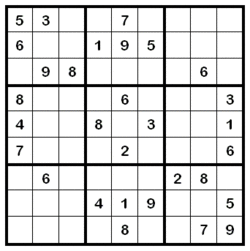Sudoku: Difference between revisions
Earth2marsh (talk | contribs) No edit summary |
|||
| Line 21: | Line 21: | ||
Scanning is performed at the outset and throughout the solution. Scans only have to be performed one time in between analysis periods. Scanning consists of two basic techniques: |
Scanning is performed at the outset and throughout the solution. Scans only have to be performed one time in between analysis periods. Scanning consists of two basic techniques: |
||
* '''Cross-hatching:''' the scanning of rows (or columns) to identify which line in a |
* '''Cross-hatching:''' the scanning of rows (or columns) to identify which line in a |
||
Revision as of 18:42, 6 June 2006

Sudoku (数独, sūdoku), also known as Number Place, is a logic-based placement puzzle. The aim of the puzzle is to enter a numerical digit from 1 through 9 in each cell of a 9×9 grid made up of 3×3 subgrids (called "regions"), starting with various digits given in some cells (the "givens"); each row, column, and region must contain only one instance of each numeral. Completing the puzzle requires patience and logical ability. An ancestor of the puzzle was published in a French newspaper in 1895 and may have been influenced by the great Swiss mathemetician Leonhard Euler who likely created Latin squares. Modern interest in Sudoku stems from a revival in Japan in 1986, leading to international popularity in 2005.
Introduction
The name "Sudoku" is the Japanese abbreviation of a longer phrase, "Suuji wa dokushin ni kagiru" (数字は独身に限る), meaning "the digits must remain single". It is a trademark of puzzle publisher Nikoli Co. Ltd. in Japan. In Japanese, the word is pronounced [sɯːdokɯ]; in English, it is usually spoken with an Anglicised pronunciation, [səˈdəʊkuː] (BrE) [səˈdoʊkuː] (AmE) or [ˈsuːdəʊku] (BrE) [ˈsuːdoʊku] (AmE) (See IPA (International Phonetic Alphabet) or IPA chart for English for notation usage.) Other Japanese publishers refer to the puzzle as Number Place, the original U.S. title, or as "Nampure" for short. Some non-Japanese publishers spell the title as "Su Doku".
The numerals in Sudoku puzzles are used for convenience; arithmetic relationships between numerals are irrelevant. Any set of distinct symbols will do; letters, shapes, or colours may be used without altering the rules (Penny Press' Scramblets and Knight Features Syndicate's Sudoku Word both use letters). In fact, ESPN has published Sudoku puzzles that substitute the positions on a baseball field for the numbers 1-9. Dell Magazines, the puzzle's originator, has been using numerals for Number Place in its magazines since they first published it in 1979. Numerals are used throughout this article.
The attraction of the puzzle is that the rules are simple, yet the line of reasoning required to reach the solution may be complex. Sudoku is recommended by some teachers as an exercise in logical reasoning. The level of difficulty of the puzzles can be selected to suit the audience. The puzzles are often available free from published sources and may also be custom-generated using software.
Gameplay
The puzzle is most frequently a 9×9 grid, made up of 3×3 subgrids called "regions" (other terms include "boxes", "blocks", and the like when referring to the standard variation; even "quadrants" is sometimes used, despite this being an inaccurate term for a 9×9 grid). Some cells already contain numerals, known as "givens" (or sometimes as "clues"). The goal is to fill in the empty cells, one numeral in each, so that each column, row, and region contains the numerals 1–9 exactly once. Each numeral in the solution therefore occurs only once in each of three "directions" or "scopes", hence the "single numbers" implied by the puzzle's name.
Solution methods
The strategy for solving a puzzle may be regarded as comprising a combination of three processes: scanning, marking up, and analyzing.

Scanning
Scanning is performed at the outset and throughout the solution. Scans only have to be performed one time in between analysis periods. Scanning consists of two basic techniques:
- Cross-hatching: the scanning of rows (or columns) to identify which line in a
